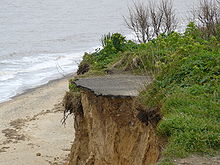- Covehithe
-
Coordinates: 52°22′34″N 1°42′20″E / 52.37618°N 1.70563°E
Cove Hithe 
The Church, Covehithe
 Cove Hithe shown within Suffolk
Cove Hithe shown within SuffolkDistrict Waveney Shire county Suffolk Region East Country England Sovereign state United Kingdom Post town Wrentham Postcode district IP EU Parliament East of England List of places: UK • England • Suffolk Covehithe, formerly North Hales, is a hamlet in a parish in Blything district, Suffolk, England.[1] Lying on the coast around 5 miles (8 km) North-east of Southwold,also 8 miles South from the town of Lowestoft. It is located within the Suffolk Coast and Heaths AONB.
Contents
History
Domesday has it named as Nordhalla / Norhals / Norhhala / Northala / -hals[1]:
Roger Bigot, the pre-Conquest holder, and Norman from him; William de Warenne; William de Boeville from Geoffrey de Mandeville.In the Middle Ages it prospered as a small town and during the reign of Edward I was granted a fair on the feast day of St Andrew. By the 17th Century however it had fallen victim, like nearby Dunwich, to coastal erosion - the large church which had been built on the back of its wealth was largely pulled down (although the tower still remains) and a smaller building erected amongst the ruins. The Carmelite Prior of Ipswich Whitefriars and later Church Of Ireland Bishop of Ossory John Bale was also born in Covehithe.[2] The church steeple is 101 ft tall.
In 1870-72, John Marius Wilson's Imperial Gazetteer of England and Wales described Covehithe like this[3]:
Acres, 1553. Real property, £973. Pop., 192. Houses, 40. The property is divided among a few. The living is a vicarage, annexed to the rectory of Benacre, in the diocese of Norwich. The ancient church was a fine structure, destroyed in the civil war; and the present one was erected in 1672, and has a handsome tower. Charities, £28. Bishop Bale was a native.St Andrews (OS grid TM5281), the present church, was built in 1672 was built inside the ruins of the old.
In 1910 Peter Ditchfield wrote[4]:
At Covehithe, on the Suffolk coast, there has been the greatest loss of land. In 1887 sixty feet was claimed by the sea, and in ten years (1878-87) the loss was at the rate of over eighteen feet a year. In 1895 another heavy loss occurred between Southwold and Covehithe and a new cove formed.Erosion caused the coastline at Covehithe to retreat more than 500 metres between the 1830s and 2001, according to contemporary Ordnance Survey maps. This can be seen most obviously on the sand cliffs above the beach where the road running from the church simply falls away down onto the beach.
The WWI Covehithe airfield was a night-landing ground which operated from 1915 to 1919. It was used for anti-Zeppelin patrols.
A possible Romano-British settlement has been inferred from a number of archaeological finds in the west of the parish.
Present day
Nowadays, population of 20.
A 1980's PD James episode (ITV) was filmed at the church ruins.
1999/2000 adaptation of David Copperfield, filmed a boat beach scene on the beach nearby.
Benacre Broad is just under mile north and Covehithe Broad, half a mile to the south.
It has also its part in the W.G.Sebalds Prose The Rings of Saturn, a record of a journey on foot through coastal East Anglia.
See also
Reference
- ^ a b "The Domeday Book online: Suffolk: C-E". http://www.domesdaybook.co.uk/suffolk2.html#covehithe. Retrieved 17 September 2010.
- ^ Robert Wake (1839). Southwold and its vicinity, ancient and modern. http://books.google.ie/books?id=EYcuAAAAMAAJ&pg=PA297&lpg=PA297&dq=covehithe+roman&source=bl&ots=RcjIKVqlsM&sig=ltGhDOuM-Wc7ADZz5QRgT50BYTU&hl=en&ei=j7GTTPStEMqNjAeJ9_moBQ&sa=X&oi=book_result&ct=result&resnum=7&ved=0CCYQ6AEwBjgK#v=onepage&q&f=false. Retrieved 17 September 2010.
- ^ "A Vision of Britain through Time". http://www.visionofbritain.org.uk/place/place_page.jsp?p_id=7105. Retrieved 17 September 2010.
- ^ Peter Ditchfield (1910). http://www.gutenberg.org/files/14742/14742-h/14742-h.htm. Retrieved 17 September 2010.
External links
Categories:- Waveney
- Villages in Suffolk
- Populated coastal places in Suffolk
Wikimedia Foundation. 2010.


